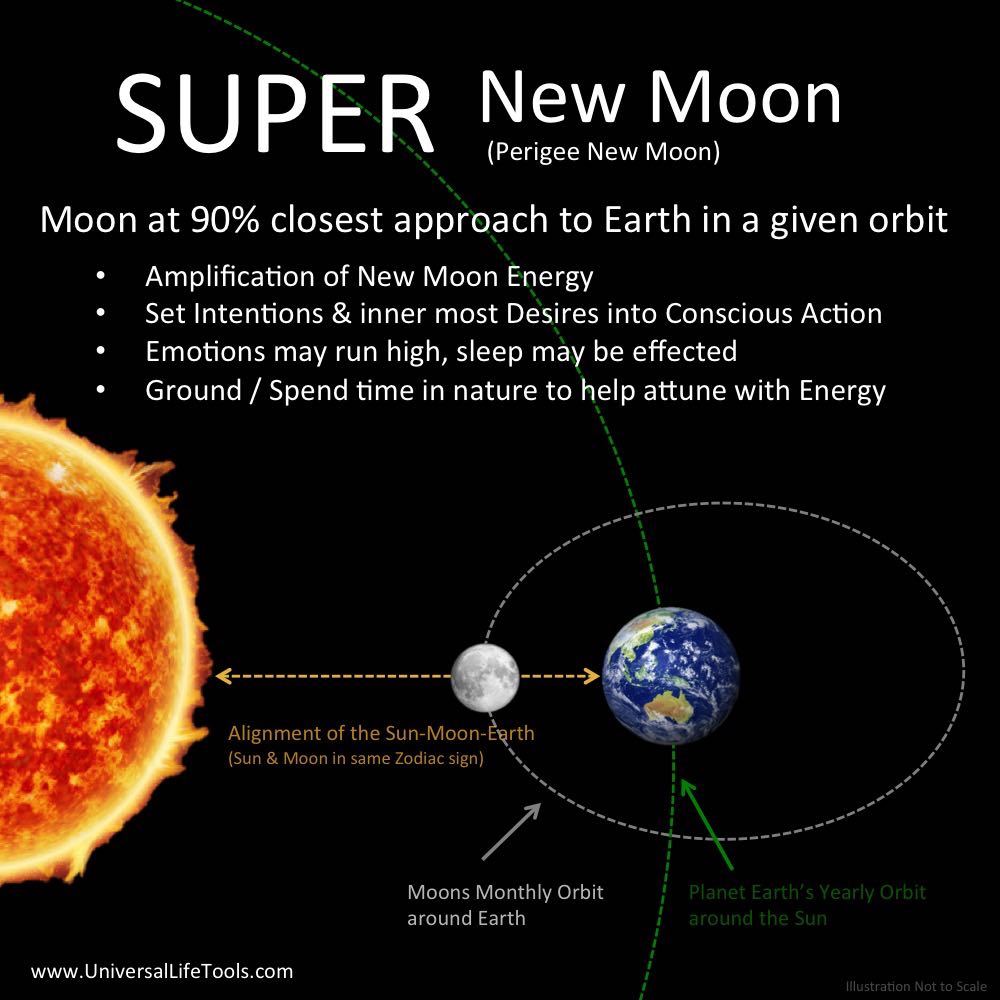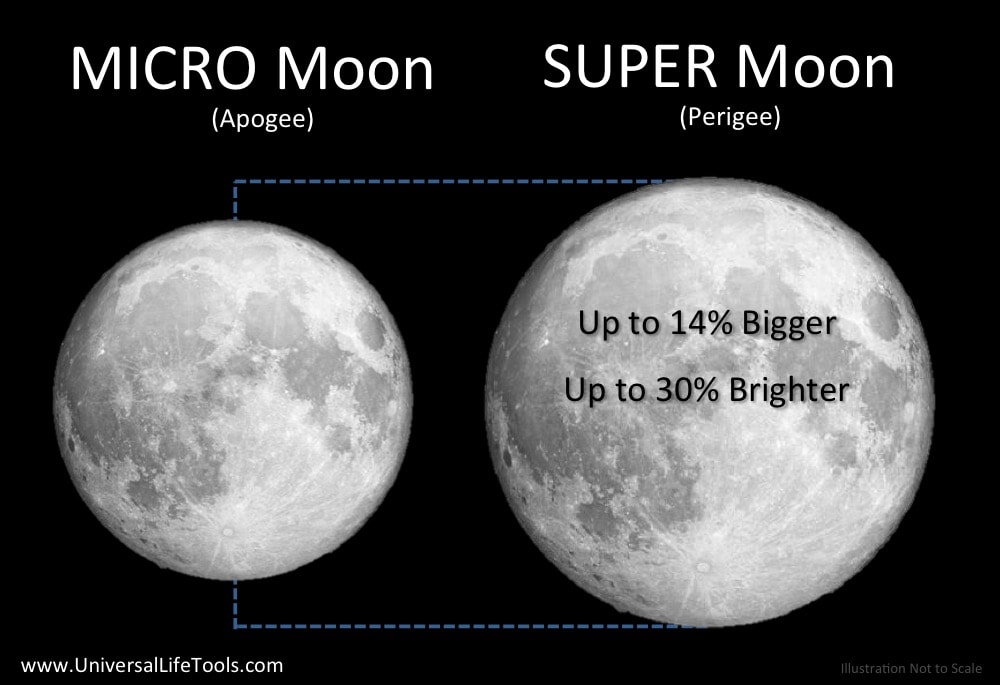The Moon orbits Earth in an elliptical orbit, hence the distance of the Moon from the Earth varies throughout the year… from between 225,804 miles (363,396 km) at the Perigee and 251,968 miles (405,504 km) at the Apogee.
A SUPERMOON is a new or full moon which occurs when the moon comes within at least 90% of its closest approach to Earth in a given orbit. A SUPERMOON is an Astrological term, whereas Astronomers call Supermoons ‘Perigee Full Moon’ or a ‘Perigee New Moon’ – with PERIGEE meaning ‘near Earth’.
A MICROMOON is the Astrological term for the Moon (New Moon or Full Moon) when it is the furthest away from the Earth. Astronomers call these moons ‘Apogee Moon’ meaning ‘away from Earth’.
Super Moons of 2016
For a Moon to be deemed a Super Moon during 2016, the Moon must come within 361,524 km (224,641 miles) of Earth, as measured from the centers of the Moon and Earth.
Based on the above definition, 2016 will have 6 supermoons: the new moons of March, April and May, and the full moons of October, November and December:
New Moon Super Moon: 9 March 2016 Find your Local Time >
New Moon Super Moon: 7 April 2016 Find your Local Time >
New Moon Super Moon: 6/7 May 2016 Find your Local Time >
Full Moon Super Moon: 16 October 2016 Find your Local Time >
Full Moon Super Moon: 14 November 2016 Find your Local Time >
Full Moon Super Moon: 14 December 2016 Find your Local Time >
According to EarthSky.org, the full moon on 14 November 2016 presents the closest supermoon of the year (356,509 km or 221,524 miles). PLUS our 14 November 2016 full moon will present the moon at its closest point to Earth thus far in the 21st century (2001 to 2100) and the moon won’t come this close again until the full moon of November 25, 2034.
Effect of Super Moons – Physical
Referring to the images above, around each Full Moon and New Moon – when the Sun, Earth & Moon are located more or less on a line in space – the gravitational pull on the Earths Oceans are affected, hence the range between high and low tides is greatest. These tides are referred to as SPRING TIDES.
During a SUPERMOON, due to the Moon being especially close to Earth, this alignment and greater gravitational pull of the Moon on Earths Oceans accentuates our Spring Tides even more… giving us an even HIGHER High Tide and an even LOWER Low Tide than normal. These amplified tides are referred to as PERIGEE SPRING TIDES.
It is unlikely that Perigee Spring Tides will cause flooding… unless of course the tides are associated with a strong weather system.
But it is interesting to note, that historically after a SUPERMOON (either Perigee Full or New Moon), strong correlations have been drawn between SUPERMOON energy and Earthquakes, Storm Cells & dramatic changes in weather patterns.
Effect of Super Moons – Energetic
Whilst Super Moons have been shown to affect the tides above, just like the Earth’s Surface humans are also made up of over 70% water… hence the gravitation pull of the Moon also affects us !
SUPERMOONS ‘amplify’ and affect our physical, emotion & mental states of beingness.
Based on the SUPERMOONS alignments with other planets, constellations & energetic bodies within our cosmos.. as well as the SUPERMOONS position within our own Astrological Charts, SUPERMOONS affect each individual differently. But what can generally be said is that SUPERMOONS are amplifiers of our energy fields and awaken higher potentials of the current planetary alignments that they are associated with.
What does this all mean ?
Energy runs high during a SUPERMOON… you may feel more emotional, electric, experience sleep disturbances or have expressive / lucid dreams. You may also find your intuition is heightened, synchronicity more pronounced and you become more aware or sensitive to the energy of the environment / people / plants / animals… actually everything !
The best way to balance with this highly charged energy is to Earth yourself by walking bare foot on the ground, hiking in nature, swimming in a lake or the ocean or connecting with Crystals / Earths Crystalline Field.
Does a Super Moon look different ?
When comparing a SUPERMOON to a MICRO Moon, the Moon’s luminosity will be up to 30% brighter and the Moon will appear from Earth to be up to 14% Bigger.
The Closest Supermoons
The dates of the closest SUPERMOONS (Full Moons) in recent and future years are as follows:
March 19, 2011
May 6, 2012
June 23, 2013
August 10, 2014
September 28, 2015
November 14, 2016
January 2, 2018.
After our November 14, 2016 SUPERMOON on the Full Moon, the next closest Full Moon SUPERMOON until January 2, 2018.
Looking further into the future, the perigee full moon will come closer than 356,500 kilometers for the first time in the 21st century (2001-2100) on November 25, 2034 (356,446 km). The closest full moon of the 21st century will fall on December 6, 2052 (356,425 km).
Micro Moons
A MICROMOON is the Astrological term for the Moon (New Moon or Full Moon) when it is the furthest away from the Earth. Astronomers call these moons ‘Apogee Moon’ meaning ‘away from Earth’.
Micro Moon is the term used by Astrologers, but Astromers refer to this as a ‘Apogee Moon’.
One fortnight (approximately two weeks) after the year’s nearest new moon on 7 April 2016, it’ll be the year’s farthest and smallest full moon (MicroMoon) on 22 April 2016.
This April 22, 2016 full MicroMoon will lie about 50,000 kilometers (30,000 miles) farther away from Earth than will the year’s closest full moon – the full supermoon on November 14. The April 22 full moon is the year’s farthest full moon because full moon and lunar apogee – the moon’s farthest point in its monthly orbit – both happen less than one day apart.
Refer to NASA & Timeanddate for more info on Micro Moons.
Article Source: http://earthsky.org/?p=175666
Article Source: http://earthsky.org/space/what-is-a-supermoon
OmAhOm
xx Simone










